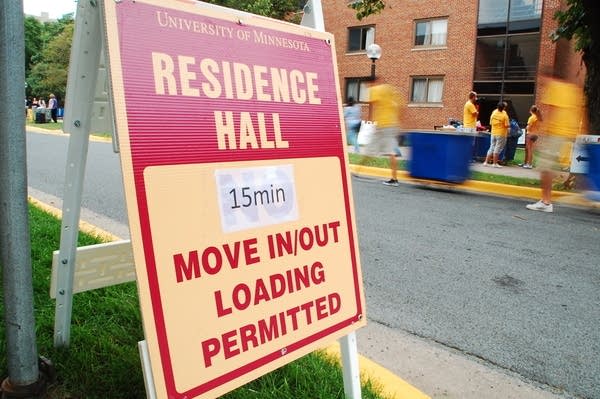How parents can adjust to an empty nest, avoid 'gray divorce'
Go Deeper.
Create an account or log in to save stories.
Like this?
Thanks for liking this story! We have added it to a list of your favorite stories.

It is peak move-in time on college campuses across the country. For some parents that means the beginning of their lives without kids in the house.
While some parents gracefully leap into this next phase of life, a growing number of baby boomers experience marital problems bubbling to the surface. "Gray divorces," splits of couples over 50, are on the rise.
"It's when people have to look at their identity outside of being co-parents, outside of being professionals and they have to assess, 'Do I know this person sitting next to me? Have we nurtured the relationship?'" said Eli Karam, assistant professor at the University of Louisville and president of the Kentucky Association for Marriage and Family Therapy, on The Daily Circuit.
In 1990, fewer than 1 in 10 individuals who divorced were 50 or older, Karam said. Now, that number has jumped to 1 in 4, accounting for more than 600,000 divorces in 2009.
Turn Up Your Support
MPR News helps you turn down the noise and build shared understanding. Turn up your support for this public resource and keep trusted journalism accessible to all.
Karam and Lise Stoessel, author and educator, offered advice on keeping marriages happy and healthy once kids leave the nest.
7 TIPS FOR IMPROVING MARRIAGE IN AN EMPTY NEST:
1. Start the dialogue before your kids move out.
"Our culture necessitates thinking about some things in advance, like most responsible adults plan some kind of college fund for their kids, they plan their own investments," Karam said. "They look into the future on some things, but as far as the relational health of the couple, something that's so paramount to the future, we find couples do very little planning until the time you wake up and look across the bed and see this person you know that's been with you every day for sometimes up to 20 or 30 years. You don't know who that person is anymore because you have not nurtured that relationship."
2. Find a balance between "me" time and "we" time.
"If you feel like all of your partner's happiness rises and falls with you, they have no outside interests or passions, their kids have launched and now they are solely focused on you, that's a lot of pressure for any partner or any relationship," Karam said.
It's important for individuals to set aside time to do things that bring fulfillment, but also come together as a couple to support that independence, he said.
3. Fix problems that are solvable and acknowledge issues that you can't resolve.
"Successful couples learn to solve what is solvable, which really the research indicates is only about 31 percent of marital issues," Karam said. "The majority, 69 percent, are really what we call unsolvable problems or perpetual issues that when you can't solve it they take acceptance and tolerance."
4. Remember the friendship component of your marriage.
"More than the nice trips, even the sexual connection, the enduring part of the relationship is the friendship," Karam said. "Just like you would with your friend, you stay up to date with their world, you understand what's important to them even if you're not there with them doing those things, how they react and change, and they do the same for you."
5. Be curious about your partner again.
"One of the biggest things I see working with long-term couples is just lack of curiosity," Karam said. "They think they have everything figured out about their partner because they've been with them 20 or 30 years."
But if you've been focused on co-parenting for decades, you might find your partner has changed more than you'd expect.
6. Establish rituals of connection.
Karam described the essential 15 minutes in a day when couples can create rituals to strengthen their marriage. He said to think about what you do during your departure in the morning and your reunion in the evening to bond with each other.
7. For some, living apart can be beneficial.
Stoessel and her husband were on the brink of divorce after their children moved out. To save their marriage, the couple decided to live in separate houses. The living arrangement gave them the space they needed and made their time together more meaningful.
"You are much more intentional with your time together," she said. "You don't take the other person for granted the way you do when you see them day in and day out. We are much better at being together when we are together."
LEARN MORE ABOUT GRAY DIVORCE:
• How to Avoid Becoming a Victim of the Gray Divorce
"These days, instead of entering the fourth quarter of marriage hoping just to hang on to health and hold each other up, we are healthy enough to look for happy. This creates a whole new set of parameters by which we judge our partners, ones that begin to resemble anew those we had when we first met." (Huffington Post)
• Is Living Apart Good for Marriage? For More Americans, Two Roofs May Be Better Than One
"According the U.S. Census Bureau, an estimated 3.5 million married couples in the U.S. are living apart. The number of married couples who live separately for reasons other than legal separation has nearly doubled since 1990." (Alternet)
• Baby Boomer Breakup: 'Gray Divorce' and Adult Children
"Adult children do not have built-in immunity to the impact of their formative family breaking up. Adult children are no more prepared for parental divorce than younger children." (Good Therapy)
• Considering a Gray Divorce?
Things to consider when you divorce after age 50. (Nerd Wallet)



